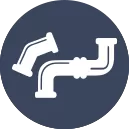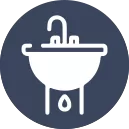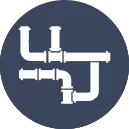Plumbing systems bring in clean water and take waste water out of buildings. They provide clean drinking water and the elimination of waste water and gases. A proper plumbing system will help avoid leaks, floods, and other health hazards.
Plumbing systems use pipes, valves, and other plumbing components. Each piece needs to fit together and work seamlessly. It saves time and money to choose the right products. It is also likely to lead to systems that are easier to maintain over the years of use.
Piping and Tubing
Pipes and tubes are the very foundation of any plumbing project. They transport water from facilities to faucets and steer waste from dwellings.
- Plastic Tubing (PEX): Soft and flexible, PEX is able to curve around corners. They are undamaged by freezing and hot water. They are often used by installers for new buildings for the water supply.
- PVC and CPVC Pipes: Rigid plastic pipes are for drain, waste, and vent lines. PVC pipe is the best suited for cold water or drainage. CPVC is good for hot water applications up to 200°F.
- Copper Pipes: Strong and pure, copper will transport potable water without adding any additional flavor. It’s impervious to corrosion but can be expensive and requires soldering.
- Steel Pipes:
- Black Iron: Primarily used for gas lines. Tough and fire-resistant.
- Galvanized Steel: Coated to prevent rust, but still corrodes over a period of decades.
- Ductile Iron Pipes: Steel pipes are for water mains. It lasts for decades on hard city streets.
Fittings and Valves
Fittings and valves join pipes and allow installers to regulate water flow. They are found in a variety of forms.
Fittings
- Elbows: Used in pipe redirection, typically 45° or 90°.
- Tees and Crosses: Split or join 2 pipes in various directions.
- Couplings and Adapters: Connect pipes of the same or comparably sized and even mixed materials.
- Unions: Provide quick removal for service.
Valves
- Ball Valves: Ball valves control water with a simple lever that can completely turn on or off.
- Gate Valves: Lift a gate to start or stop flow; they can be used with steam and cold water.
- Globe Valves: Adjust flow, and are good for applications where flow needs to be fine-tuned.
- Check Valves: If water tries to return, these close to stop backflow.
- Pressure-Reducing Valves: Maintain safe levels of water pressure for pipes and fixtures.
Plumbing Fixtures
Fixtures are the exit and entry points of water for living spaces. They impact a client’s comfort, hygiene, and water habits.
- Sinks and Faucets: These are located in kitchens, bathrooms, and utility rooms. They’re made from stainless steel, porcelain and composites.
- Toilets: One-piece units to wall-hung models are available. Low-flow models cut water usage while still getting the job done.
- Showers and Bathtubs: Choices are walk-in showers, soaking tubs, and whirlpool tubs. Most have ceramic tile or acrylic surfaces and low-flow showerheads conserve water.
- Specialty Fixtures: Drinking fountains, bidets, and mop sinks respond to special needs in schools, hotels, and workshops.
Pumps and Water Management
Pumps take over when the force of gravity isn’t sufficient to move the water. They guard basements, hoist wastewater, increase water pressure.
- Sump Pumps: Sit in basins that are under the level of the basement floors. When water rises, they switch on, pumping the water outside to prevent flooding.
- Sewage Ejector Pumps: Transfer gray and black water waste from a lower level to the sewer when gravity cannot drain the system. A built-in grinder or macerator is frequently integral.
- Grinder Pumps: Break the waste into a slurry by grinding solids. Perfect for regions with no local service or low-pressure systems.
- Booster Pumps: Boosts water pressure for multi-story buildings or long runs of pipe. They ensure showers and taps operate smoothly, even under high demand.
- Submersible Pumps: The Motor is sealed in a water tight housing mounted on the pump. Easy to install, corrosion resistant, and works for wells or treated water tanks.
Water Treatment and Filtration
Clean water is important for health and the longevity of equipment. This section includes units that filter out much of the dirt, impurities, minerals and germs.
- Keep sand, dirt, and rust out of valves and washers.
- Removes chlorine, bad tastes and odors.
- Exchange hardness minerals (calcium and magnesium) for sodium or potassium. Soft water does not leave scale buildup in pipes and appliances.
- Eliminate bacteria and viruses once and for all, without using chemicals.
- Pressure water through a very fine membrane to remove between 94-99% of all dissolved solids.
- Automatically feed sterilizers and pH-adjusting chemicals in large systems.
Insulation, Supports, and Accessories
Success in plumbing is about more than just pipes and fixtures. Small parts, insulation, brackets and the accessories are the rest of the work.
- Foam and fiberglass sleeves will keep hot water hot and prevent freezing pipes. And they prevent condensation on cold pipes.
- Fasten pipes to walls, ceilings, or floors. Good support prevents the mat from caving and makes noise.
- Stop leaks in threaded joints with an air tight seal.
- Plug flared and compression fittings to fill in gaps and ensure a tight fit.
- Heat-shrink tubes and wrap tapes protect metal pipes from rusting in wet conditions.
Quality and Compliance
Products need to comply with industry standards to maintain safe water and reliable systems.
- Material and performance requirements are established by ASTM and ANSI.
- Installation guidelines are provided by local building and plumbing codes and by the Uniform Plumbing Code (UPC) or International Plumbing Code (IPC).
- These labels, such as NSF, CSA and UL, indicate that a product was tested for safety and sanitation.
Installation Tools and Safety
Good tools and good work habits make plumbing work go faster and more smoothly.
- Cutting Tools: Tube cutters as well as saws provide a neat pipe end.
- Threading and Flaring Tools: Prepare metal pipe ends for threaded or flare fittings.
- Press and Compression Tools: Crimp pipe rings and sleeves without heating.
- Soldering Equipment: Solder copper pipe, using torch, flux, and lead-free solder.
- Testing Pumps and Gauges: Check pressure and look for leaks before covering pipes.
- Safety Gear: Gloves, eye protection and respirators help protect installers from sharp edges, fumes and refuse.
Conclusion
It is a category that combines everything necessary for water supply, drainage, and treatment. It leads professionals and DIYers through selecting the best pipe, fittings, valves, taps, fixtures, pumps and accessories. The right products, installation tools and safety measures can help plumbing systems not only run more efficiently but also last decades, even as they save water and energy.



